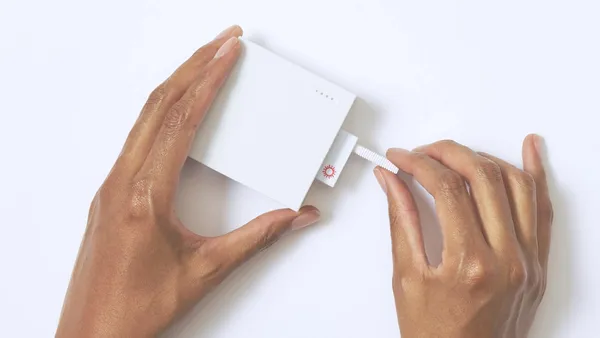Dive Brief:
- Despite a global slowdown in elective procedures, Stryker increased fourth-quarter sales by 3.2% to about $4.3 billion, though it fell short of Wall Street estimates. The quarter is slightly down from third-quarter results, which executives attributed to the procedure drop off, but the quarter was a significant improvement over the 24.3% sales decline taken in the second quarter.
- The procedure declines varied across geographies but impacted about 40-50% of the company's business, Preston Wells, Stryker's vice president of investor relations, said Wednesday during a fourth-quarter earnings call.
- Robotics helped prop the company up and remained successful despite the hit to procedures, with over 100 Mako systems sold and placed in the quarter. CEO Kevin Lobo said that he was "very bullish" on the continued success of robotics in 2021.
Dive Insight:
Stryker is the latest medtech impacted by a slowdown in procedures due to a resurgence of the virus across the globe. Both Abbott Laboratories and Johnson & Johnson outlined similar experiences on fourth-quarter earning calls this week. However, all three companies said that procedure volumes did not slow down as much as last spring when hospitals in the U.S. and abroad largely shut down all non-essential care.
Wells said that the impact varied geographically as countries had a different severity of the virus resurgence and implemented multiple strategies to slow the spread.
"As a result, revenue was uneven and correlated to the state of the pandemic in each region. The areas impacted the most include the U.S. and many of the countries in Western Europe, most notably the United Kingdom, driven by a countrywide lockdown," Wells said. "[However,] we saw growth in emerging markets, including China, which grew double digits over the prior year quarter."
Lobo said that after volumes rebounded throughout the second half through October, large declines began in November and December.
Much like Johnson & Johnson's orthopaedics business in the quarter, Stryker took hits in knee and hip procedures but saw strong numbers in trauma. The trauma and extremities segment grew year over year by 29% to $570 million, while knees and hips dropped by 10.2% and 8.3%, respectively.
Overall, orthopaedics brought in about $1.5 billion in quarterly sales, a year-over-year growth of 4%. Meanwhile, the company's medical and surgical equipment business had sales grow by 2.3%, fueled by a 10.8% increase for medical equipment.
Executives expect procedure volumes to remain low throughout the first quarter of 2021 but slowly come back throughout the rest of this year. Wells said that some of the procedures over the last three to six months have been deferred rather than canceled, leaving opportunities to recapture them as hospitals' operations normalize.
The company's overall sales for the quarter missed expectations by about $68 million; however, this was "more of an in-line performance given the more conservative commentary we had heard from MedTech peers heading into the print and are unsurprised to see Stryker hit harder by its exposure to Orthopedics and capital businesses," J.P. Morgan analysts wrote.
Overall, the company saw sales drop by $14.4 billion, or 3.6%, in 2020.
Stryker projected an organic sales growth of 8-10% compared to 2019 levels. Analysts were mostly mixed on the guidance provided. J.P. Morgan felt the guidance was in line with expectations, while analysts from Jefferies wrote that the guidance was above their initial estimates.
Evercore ISI analysts wrote that the range could be challenging as continued procedure declines in the first quarter will require the company to make up for the slowdown in the rest of the year.
"While [Stryker] is known for its commercial execution, these assumptions don't leave room for error," the analysts wrote.
Robotics remained successful despite COVID-19 pressures. Stryker sold and placed 100 robots and Mako's installation base grew by 33% in 2020, according to Wells. In the fourth quarter, about 44% of all total knee replacement procedures for Stryker were done with the Mako robot.
Lobo said that the entrance into the space from rivals — particularly Johnson & Johnson's new system — did not concern him.
"The introduction of competitive systems has not slowed down the Mako momentum whatsoever, and we don't expect that to change with one more system on the market," Lobo said. "If anything, it just proves to further validate that robotics is here to stay."
The CEO was also bullish on the continued growth in procedures conducted at ambulatory surgical centers. Procedures have shifted to these facilities over the years as payers have expanded coverage. Among other services, CMS added total hip replacement to the ASC covered procedures list in December, following the addition of total knee replacements in 2019.
Lobo said that while ASCs are still a smaller business for Stryker, these procedure additions will further fuel the migration of procedures out of hospitals and into the facilities. The CEO added that the centers are actually financially stable and "very profitable" due to their ability to cut costs compared to hospitals.
"This is a trend for the future, and I actually think it's not going to stop in the United States. There are already countries like the U.K. and even Canada looking at moving lower-cost sites of care," Lobo said. "You can debate the actual pace of the curve, but there's no doubt in my mind that this is a trend that's going to continue to accelerate."












